Family : Pisauridae

Text © Prof. Giorgio Venturini

English translation by Mario Beltramini
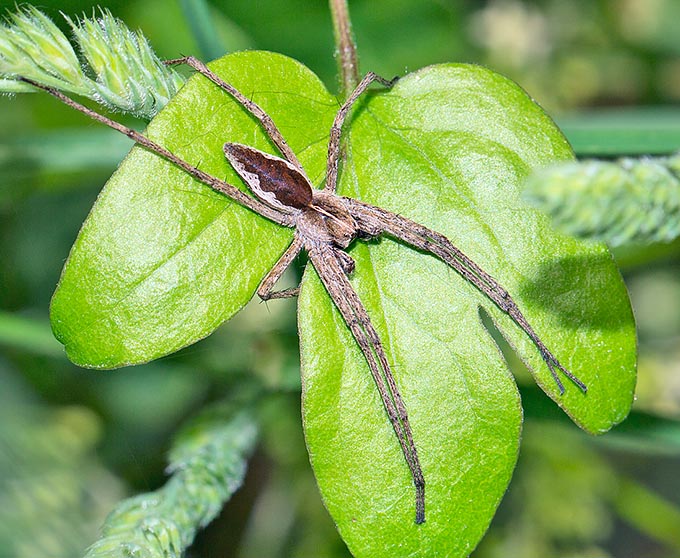
Pisaura mirabilis awaiting a prey, in the typical position with the firs two pairs of legs joined and protruded ahead. This species is very common in all Europe, Turkey and Middle East; less in Asia and North Africa © Giorgio Venturini
The family Pisauridae includes two genera, Pisaura and Dolomedes.
The genus Pisaura includes 18 species with palearctic distribution.
Pisaura mirabilis Clerck (1757) is present in all Europe, in Turkey and in Middle East, besides, less common, in the temperate regions of Asia and of North Africa.
In Italy, besides this species are present, rarer, Pisaura novicia, Pisaura orientalis and Pisaura quadrilineata, present in Sardinia and in Sicily.
The etymology of the name of genus Pisaura is not sure. Pisaurus in Latin indicates the city of Pesaro or a river of the Piceno close to which settled Gallic Senones populations around the 400 BC. After a French student, the name of the spider is referred to these places or to these populations.
The name Pisaura, for what concerns the plant genus of the same name, comes from the name of the city of Pesaro. For what concerns the species mirabilis in Latin this means admirable, remarkable, probably referring to the remarkable parental cares the mother gives to the progeny.
Ecology-Habitat
This spider loves the open and semi-shades sites, therefore the clearings of the woods, meadows, gardens and moors, where it is easily met on grassy plants, shrubs and hedges. It is frequent up to about 1000 m of altitude.
Morpho-physiology
The adults of Pisaura mirabilis are found from May to July. The male can be 10-12 mm long, the female 1-15 mm. The opisosthoma (abdomen) is slender, fusiform, pointed on the back. The prosoma (cephalothorax) is relatively big and elongated. Long and robust legs. The eight eyes are arranged in an anteroinferior line of four, very small, and in an upper group of four, of which two, bigger, close to each other, and the two smaller ones above and more spaced.
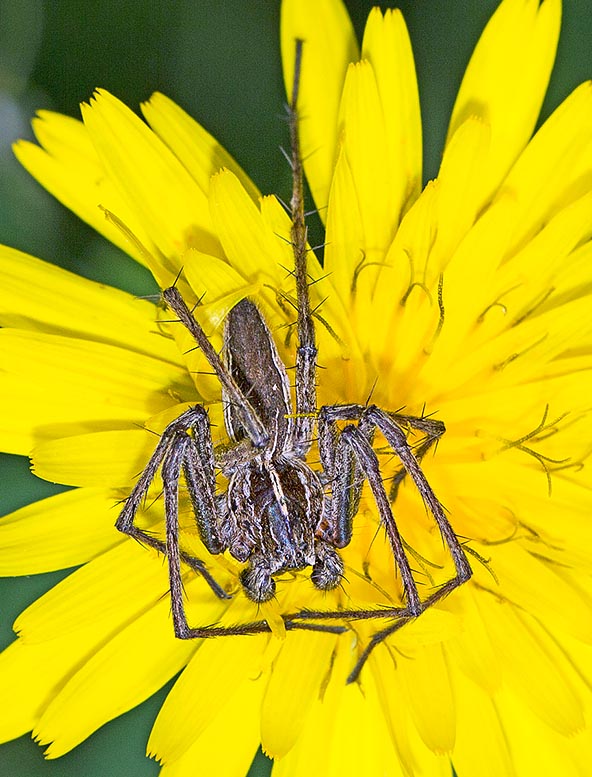
Conversely, when resting, it keeps huddled for confusing the predators © Giorgio Venturini
Usually the males have smaller abdomen and very developed palps with very big extremities.
The basic colouration goes from the pale brown to the grey the dark brown, with the males usually darker than the females. The prosoma presents a dark median band with blurry edges on the back, and a paler line at the centre. Often, the pale line is in relief to form a small crest protruding also ahead. The cephalic zone has a dark triangular spot from the chelicerae up to the central eyes. The opisthosoma has some angular dorsal spots and, laterally, a dark undulated line.
Ethology-Reproductive Biology
These spiders are good hunters, endowed of good eyesight. They do not build a web but they hunt on the ground or on the plants and, when they are waiting for a prey, they get a typical position with the first two legs joined and protruded ahead.
They often stay resting on the leaves or on the flowers assuming a typical position, with the legs united and huddled, probably with a mimetic purpose in order not to give the predators the typical spider shape with the eight legs extended and spread apart. Normally it does not bite the man, in any case the bite is not dangerous and is little painful.
The reproductive behaviour of Pisaura mirabilis is extremely complicated and interesting, for what concerns the courting phase as well as for that of the fecundation and finally of the caring of the progeny.
Before the mating the male seizes a prey, wraps it in silk thread like a cocoon, then looks for a female and introduces itself keeping the prosoma raised and the anterior limbs apart and vibrating, while with the chelicerae offers its prey as wedding gift (this behaviour has been described by Van Hasselt in 1884).
The female gets closer and tastes the gift, and now usually assumes a passive stance: the male approaches and creeps laterally under the female from one side before, then from the other and every time inserts the pedipalps in the openings of the epigyne releasing the sperm, repeating the same operation even twice with a duration up to two hours (the male previously ejaculates the semen on a small web specifically woven and then takes it with the palps, that well be utilized for inserting it into the two genital orifices of the female). The mating may take place during the day and also during the night.
The use of a nuptial wedding tending to favour the coupling is diffused in many, even if taxonomically quite different, species, from the onychophores to the insects, the birds and up to the man. In this last case the phenomenon appears much similar to that of the spider, for the goals as well as for the strategies.
This spider is commonly known in English as “nursery web spider”. The female, some time after the coupling, builds up, in fact, an ovisac of about 1 cm full of fecundated eggs and carries it keeping it under the prosoma with the chelicerae (contrary to other spiders who hold the sac with the spinnerets and carry it under the abdomen).
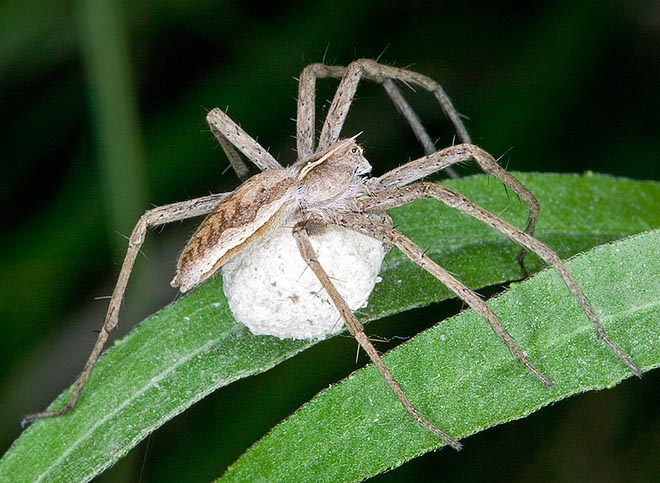
A female, slightly bigger, with its sac of eggs © Giuseppe Mazza
After about two weeks, the female fixes the sac to the vegetation and weaves around it, as protection, a dome-shaped web of about 5 cm of diameter, then opens partially the sac and stands guard on the dome for surveying the development.
After the birth, the young gather close to the ovisac and, if disturbed, disperse but soon the group again. The mother, if disturbed, goes away but quickly comes back to the web. After the first moult the young leave the web where they were born. Since the female transports the sac with the chelicerae, it cannot catch preys and does not nourish, as does not nourish during the time when it surveys the nest, and consequently does not survive long.
The characteristic domes of web of this spider can be often observed in a great number on the vegetation. Similar behaviours have been proved in other spiders such as the Paratrechalea ornata of the family Trechaleidae.
Experimental studies on the nuptial gift and the male’s apparent death
The offering of the nuptial gift is a very interesting behaviour and relatively common in the animal world, but how much is it really important for the reproduction, how does it work and how mush is it expensive for the male and how much useful for the female?
Various researchers have studied the meanings of the nuptial gift in Pisaura, with very interesting even if sometimes contrasting, results. It has been suggested that the nuptial gift of a prey done by a male of Pisaura may have the function of defence against the sexual cannibalism during the courting and the mating. Alternatively, we can think that it is a form of demonstration, done by the male, of its own ability as hunter, on view of a sexual selection or, again as alternative, of an energetic investment done by the future father for the development of the progeny. In order to verify these hypotheses some experimental studies have been done where a group of males did not offer any prey, whilst other groups offered preys of different size. In any case, none of the 82 males studied has been eaten by the female and the few aggressions have occurred against males who had offered a gift.
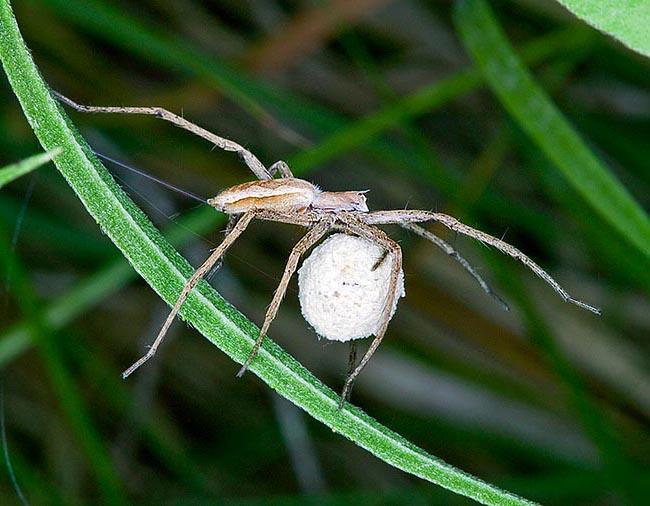
It takes it everywhere, with admirable parental cares, as the scientific name states © Giuseppe Mazza
The males without gift were able to mate in the 40% of the cases, whilst those with gift in the 90% and the duration of the mating was proportional to the size of the gift. Also the percentage of fecundated eggs did increase with the duration of the mating and therefore with the dimensions of the gift. The number and sizes of the newborns were not influenced by the gift.
These results seem to exclude the hypotheses of the cannibalism and of the energetic investment and the researchers think that, on the contrary, they substantiate the hypothesis of an exhibition done by the male about its own good quality. It should then be matter of a behaviour favoured by the sexual selection.
As the nuptial gift is expensive for the seizing as well as for the wrapping, males in poor health conditions will not be able to offer valid gifts and therefore will have lesser possibility of reproducing. The capacity to prepare the nuptial gift can be considered as a good signal about the conditions of the male.
On the other hand, fasting females accept more easily gifts and sexual relations than the well fed females; therefore the gift has also an alimentary function. Moreover, it seems that the females favour the polyandry for getting an alimentary advantage thanks to the fact of receiving more gifts.
Some student has suggested that the nuptial gift can be used instead as sensorial trick, mimicking the ovarian sac of the female with the purpose of stimulating the maternal instinct.
The experimental findings do not support this hypothesis, seen that the shape or the silky wrapping of the gift pack do not influence the acceptance by the female and, on the contrary, the gifts not wrapped in silk appear to be better accepted than the wrapped ones. It seems that the wrapping favours however the male because, maybe due to the time necessary for “unwrapping” the gift, the risk that the female steals the pack and goes away without giving herself decreases.
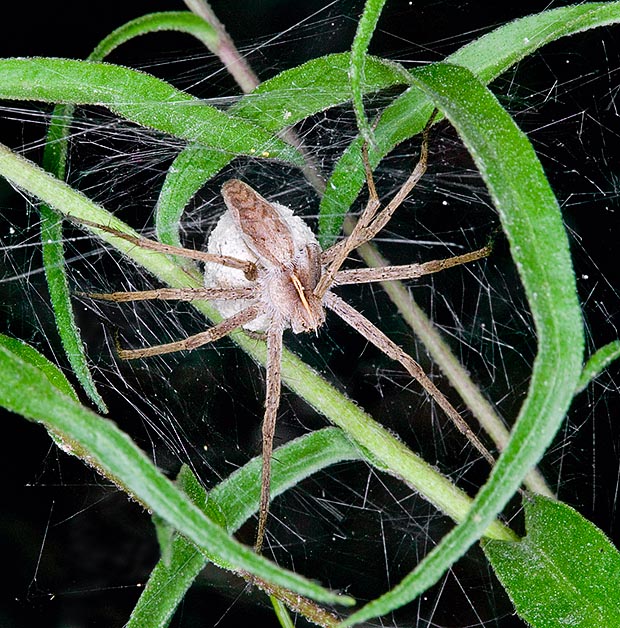
Then, after a couple of weeks, it sticks the sac on the vegetation, and weaves around, as protection, a dome-shaped web of about 5 cm of diameter. Then opens partly the sac to observe the progeny development © Giuseppe Mazza
But other observers affirm that the dimensions of the gift increase the duration of the mating, but the brightness of the package increases the acceptance by the female.
Some observer has also reported of males offering fake gifts, that is, not edible objects like leaves or twigs well packaged with the silk. It seems that these attempts of deception usually do not succeed. Therefore, it seems that the quality of the packaging is in some way important but not decisive.
The female can accept more nuptial gifts and can be inseminated by more than one male. It seems that in case of two males the sperm of the first one has more probability of fecundating the eggs. Less evident is the advantage of the first male in the case that the number of males is more than two.
The effectiveness of the gift for reproductive purposes appears well confirmed by experimental studies. In fact, by measuring in the females the quantity of sperm retained due to previous couplings preceded or not by a nuptial gift, with equal duration of the intercourse, the sperm of the males who have offered a gift is more retained and leads to the birth of more sons, even independently from the greater or smaller duration of the mating.
With true or fake gifts, the female accepts equally the partner, but in the case of false gifts the intercourse is shorter. The false gift is counterproductive for the male who will then produce less progeny. The preparation of the gift involves high costs for the male and the males in poor conditions invest less time and less silk in this activity. By studying well fed or fast males and well or badly prepared gifts it is found that the males in good conditions obtain more easily the coupling and get longer copulations. The males carrying gifts are slowed in their run but are not damaged by the fights with other males. Studies carried on the field show that the 40% of the males do carry gifts and that these ones contain fresh arthropods. The mass of the prey is proportional to the size of the package. It seems therefore that the males generally do not tend to simulate particularly attractive gifts fooling the female with the packing.
The shape and the colour of the package have no influence and also gifts not wrapped in silk are accepted, often even better than those well done. The advantage of the package stands however in the fact that it lessens the probability that the female accepts the gift and then does not mate with the male. Great and long gifts are difficult to be handled for the male and therefore lead to shorter couplings, consequently a spherical gift is not more accepted but is more comfortable for the male.
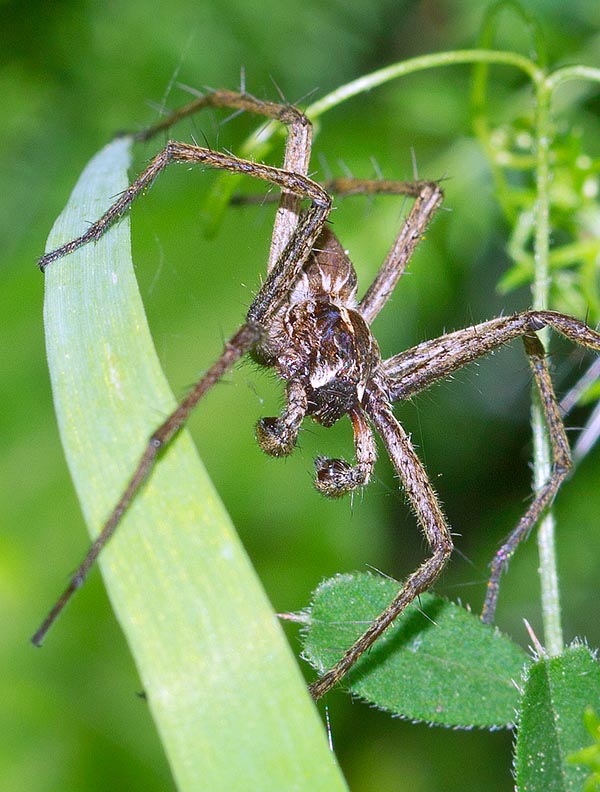
To ingratiate the partner, the male offers gifts: often bright preys, wrapped, ready to be eaten. At times feigns dead to surprise the female and usually is more successful in mating © Giorgio Venturini
At times if it happens that the male completes the transfer of the sperm before that the female has consumed the gift, he tries to take it back for eating it himself, or for offering it to another female.
In turn, the female at times tries to escape with the gift without mating. Some have observed that the male holds the gift with a thread, maybe for avoiding this theft.
From the point of view of a female, to evaluate the male basing on the gift should depend from the presence or not of previous mating. For a virgin to refuse a male might mean loosing the possibility of reproduction. Therefore we should expect that the virgins are less pretending than the females already fecundated.
However, this hypothesis has not been experimentally confirmed and the gift leads to the success of the male independently from the status of virginity or not, of the female.
Another strategy the male acts in order to facilitate the coupling is that of the apparent death (thanatosis). For some not well known mechanism, by feigning dead, the male is able to overcome more easily the resistance of the female and to maintain the contact.
If the female attacks, the male feigns dead staying motionless. When then the female begins to eat the gift, the male carefully resumes moving and starts the copulation. The males who feign dead can have more couplings, but of short duration.
In order to study the role of the thanatosis, normal males and males artificially rendered invalid by amputation of a leg, and therefore more vulnerable, have been put in contact with more or less aggressive females (behaviour evaluated in basis of the behaviour towards the preys).
By confronting the tendency to exhibit the simulated death, the success in the mating and the duration of the same, and considering also the status of virginity, or not, of the female, it has been noted that the frequency of thanatosis is not influenced by the conditions of the male (invalid or not) or by those of the female (virgin or not and aggressive or not). Generally, males more exhibiting the behaviour of apparent death were more successful in the coupling. Some males are more inclined to the thanatosis and others are less.
Synonyms
Araneus mirabilis Clerck, 1757; Aranea listeri Scopoli, 1763; Aranea arcuatolineata Martini & Goeze in Lister, 1778; Aranea flavostriata Martini & Goeze in Lister, 1778; Aranea tripunctata Martini & Goeze in Lister, 1778; Aranea rufofasciata De Geer, 1783; Aranea marmorata Fourcroy, 1785; Aranea agraria Olivier, 1789; Aranea obscura Fabricius, 1793; Aranea bivittata Risso, 1826; Ocyale murina C. L. Koch, 1837; Dolomedes scheuchzeri Bremi-Wolff, 1849; Pisaura listeri Dahl, 1908.
